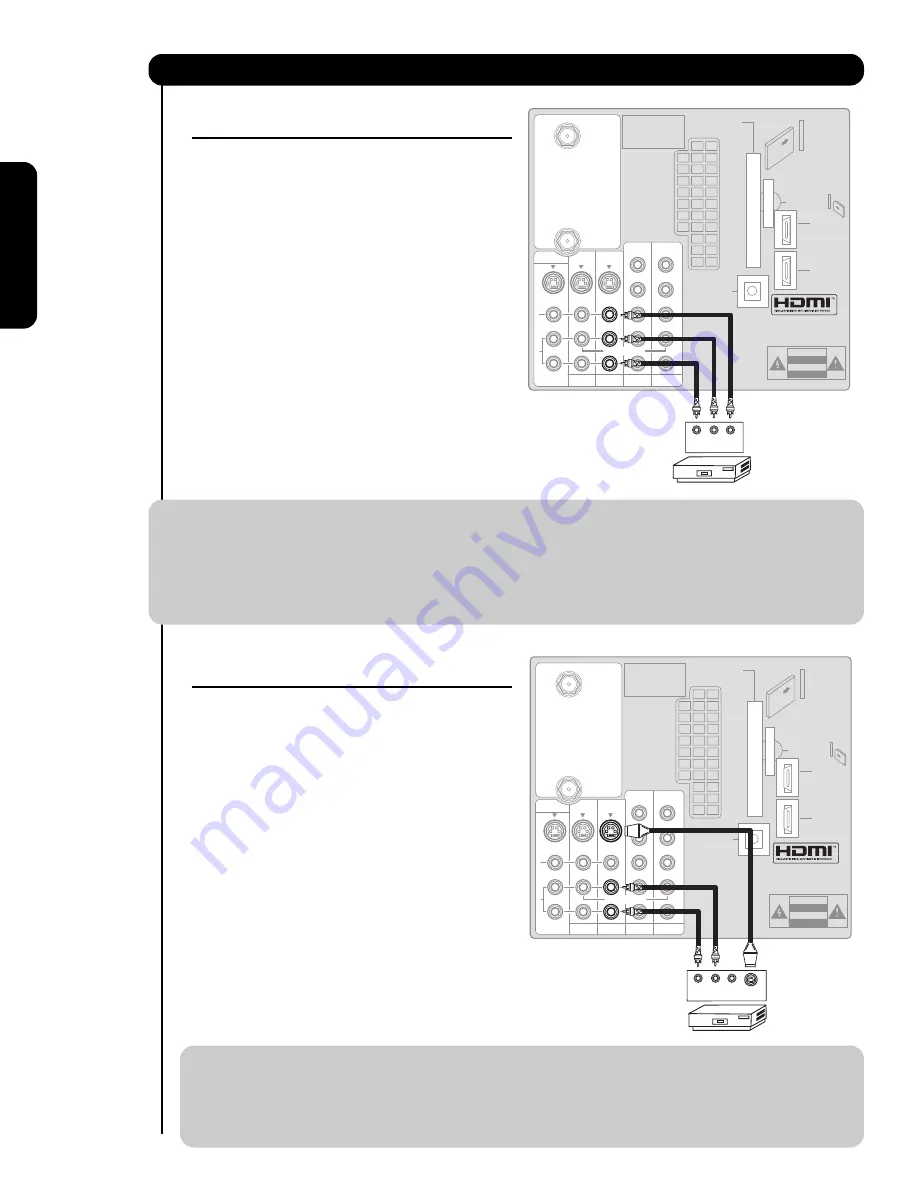
16
First time use
Connecting External Video Sources
CONNECTING A COMPOSITE VIDEO AND
STEREO AUDIO SOURCE TO INPUT1 – INPUT5
1.
Connect the cable from the VIDEO OUT of the VCR
or the laserdisc player to the INPUT (VIDEO) jack,
as shown on the TV set on the right.
2.
Connect the cable from the AUDIO OUT R of the
VCR or the laserdisc player to the INPUT
(AUDIO/R) jack.
3.
Connect the cable from the AUDIO OUT L of the
VCR or the laserdisc player to the INPUT (AUDIO/L)
jack.
4.
Press the
INPUTS
button, then select
INPUT 2
from the
INPUTS
menu to view the program from
the VCR or laserdisc player. The VIDEO OSD label
disappears automatically after approximately four
seconds.
5. Select
CABLE
from the
INPUTS
menu to return to
the previous channel.
NOTE:
1. Completely insert the connection cord plugs when connecting to rear panel jacks. The picture and
sound that is played back will be abnormal if the connection is loose.
2. A single VCR can be used for VCR #1 and VCR #2 (see page 13), but note that a VCR cannot record
its own video or line output. Refer to your VCR operating guide for more information on line input-
output connections.
3. When Input 3 or 4 are used, it’s necessary to connect the video output from the device to the
Y/Video input jack of the TV.
CONNECTING AN S-VIDEO
SOURCE TO INPUT 1, 2 AND 5
1.
Connect the cable from the S-VIDEO OUT of the
VCR or the laserdisc player to the INPUT (S-VIDEO)
jack, as shown on the TV set on the right.
2.
Connect the cable from the AUDIO OUT R of the
VCR or the laserdisc player to the INPUT
(AUDIO/R) jack.
3.
Connect the cable from the AUDIO OUT L of the
VCR or the laserdisc player to the INPUT (AUDIO/L)
jack.
4.
Press the
INPUTS
button, then select
INPUT 2
from the
INPUTS
menu to view the program from
the VCR or laserdisc player. The VIDEO OSD label
disappears automatically after approximately four
seconds.
5. Select
CABLE
from the
INPUTS
menu to return to
the previous channel.
NOTE:
1. Completely insert the connection cord plugs when connecting to rear panel jacks. The picture and
sound that is played back will be abnormal if the connection is loose.
2. A single VCR can be used for VCR #1 and VCR #2 (see page 13), but note that a VCR cannot record
its own video or line output. Refer to your VCR operating guide for more information on line input-
output connections.
R
L
A
U
D
I
O
V
I
D
E
O
S
I
V
I
D
E
O
(MONO)
(MONO)
(MONO)
(MONO)
P
R
P
B
Y/
VIDEO
Y/
VIDEO
P
R
P
B
P
R
P
B
P
R
P
B
MONITOR OUT
AUDIO
TO HI-FI
INPUT 1
CABLE
AIR
INPUT 2
TV AS CENTER
INPUT 3 INPUT 4
CableCARD™
CAUTION
(Top of card faces right)
Top faces
OPTICAL OUT
Digital Audio
Upgrade Card
HDMI INPUT 1
Apparatu
s
Claim
s
of U.
S
.
Patent No
s
. 4,631,603;
4,577,216; 4,819,098;
4,907,093; and 6,381,747
licen
s
ed for limited
viewing u
s
e
s
only.
V
L
R
VCR
OUTPUT
HDMI INPUT 2
R
L
A
U
D
I
O
V
I
D
E
O
S
I
V
I
D
E
O
(MONO)
(MONO)
(MONO)
(MONO)
P
R
P
B
Y/
VIDEO
Y/
VIDEO
P
R
P
B
P
R
P
B
P
R
P
B
MONITOR OUT
AUDIO
TO HI-FI
INPUT 1
CABLE
AIR
INPUT 2
TV AS CENTER
INPUT 3 INPUT 4
CableCARD™
CAUTION
(Top of card faces right)
Top faces
OPTICAL OUT
Digital Audio
Upgrade Card
HDMI INPUT 1
Apparatu
s
Claim
s
of U.
S
.
Patent No
s
. 4,631,603;
4,577,216; 4,819,098;
4,907,093; and 6,381,747
licen
s
ed for limited
viewing u
s
e
s
only.
V
S-VIDEO
L
R
VCR
OUTPUT
HDMI INPUT 2
Summary of Contents for 50VF820 - 50" Rear Projection TV
Page 67: ...67 Notes ...
Page 68: ...68 Notes ...
Page 69: ...69 Notes ...
Page 70: ...70 Notes ...
Page 71: ...71 Notes ...
Page 72: ...QR64441 ...















































